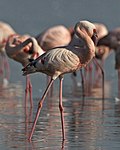 | source. Marine Synechococcus species are traditionally not thought to fix nitrogen. In the last decade, several strains of Synechococcus elongatus have... 29 KB (3,251 words) - 22:23, 21 March 2024 |
 | strains of Synechococcus elongatus have been produced in laboratory environments, which ultimately led to the production of Synechococcus elongatus UTEX... 6 KB (675 words) - 02:15, 24 September 2023 |
 | cyanobacterium UCYN-A, Trichodesmium, as well as Prochlorococcus and Synechococcus. From these lineages, nitrogen-fixing cyanobacteria are particularly... 178 KB (17,513 words) - 07:32, 10 May 2024 |
 | Paulinella amoeboids of the cyanobacteria genera Prochlorococcus and Synechococcus, or the "PS-clade". Secondary and tertiary endosymbiosis events have... 29 KB (3,233 words) - 15:20, 29 April 2024 |
co-workers was the first to recognize clearly that the cyanobacterium Synechococcus sp. RF-1 was exhibiting circadian rhythms, and in a series of publications... 44 KB (5,298 words) - 05:27, 25 March 2024 |
 | marine sample of photosynthetic picoplankton by flow cytometry showing three different populations (Prochlorococcus, Synechococcus, and picoeukaryotes)... 61 KB (6,939 words) - 15:17, 21 April 2024 |
 | nidulans, Synechococcus cedrorum, Synechococcus elongatus and Microcystis aeruginosa. Similarly, the unicellular blue-green algae Synechococcus elongatus... 36 KB (4,104 words) - 22:21, 27 March 2024 |
 | In the Black Sea, several species are present, and as an example, Synechococcus spp. can be found throughout the photic zone, although concentration... 116 KB (11,620 words) - 22:54, 12 May 2024 |
 | marine environments are represented by the genera Synechococcus and Prochlorococcus. Synechococcus is cosmopolitan, having been reported across temperate... 38 KB (4,469 words) - 16:29, 22 April 2024 |
discovered and characterized robust, 24-hour rhythms of nitrogen fixation in Synechococcus cyanobacteria, demonstrating circadian rhythmicity in a prokaryotic... 23 KB (2,981 words) - 09:19, 3 April 2024 |
Rothschild, L. J. (1998). "Biopan-survival I: Exposure of the osmophiles Synechococcus SP. (Nageli) and Haloarcula SP. To the space environment". Advances... 46 KB (3,696 words) - 20:10, 13 April 2024 |
 | this is debatable. As an example, the structure of C-phycocyanin from Synechococcus vulcanus has been refined to 1.6 Angstrom resolution. The (αβ) monomer... 33 KB (3,824 words) - 08:28, 6 May 2024 |
 | Moore (1995) Fatty acid Sulfolipid Linolenic acid Lyngbya lagerheimii Synechococcus sp. Gustafson et al. (1989) Ohta et al. (1994) Terpene Triterpenoid... 31 KB (3,352 words) - 02:46, 23 April 2024 |
such as Prochlorococcus, which contains divinyl-chlorophyll a and b. Synechococcus, colored red with phycoerythrin, is adapted to coastal bodies, while... 4 KB (514 words) - 10:02, 11 February 2024 |
 | varies from organism to organism. For instance, the cyanobacterium Synechococcus elongatus (Thermosynechococcus elongatus) has about 100 chlorophylls... 21 KB (1,936 words) - 21:13, 4 April 2024 |
 | (formerly Spirulina) (notably A. platensis), Anabaenopsis, Cyanospira, Synechococcus or Chroococcus. In more saline soda lakes, haloalkaliphilic archaea... 31 KB (3,010 words) - 06:40, 22 April 2024 |
 | structures called chromatophores, descended from the cyanobacterium Synechococcus. Chromatophores cannot survive outside their host. Chromatophore DNA... 193 KB (18,774 words) - 07:28, 10 May 2024 |
 | A. sanguinea is found to be capable of ingesting the cyanobacterium Synechococcus sp. at values comparable to other heterotrophic phytoplankton. This... 11 KB (1,247 words) - 01:11, 13 March 2024 |
 | are dominated by cyanobacteria, such as Spirulina, Oscillatoria, and Synechococcus, and green sulfur bacteria such as Chloroflexus. These organisms are... 52 KB (6,074 words) - 21:15, 27 April 2024 |
 | the requirements of two specific cyanobacteria: Prochlorococcus and Synechococcus. Prochlorococcus is the dominant species of picophytoplankton within... 68 KB (8,189 words) - 14:51, 26 March 2024 |









